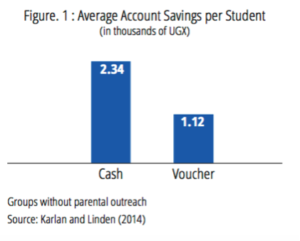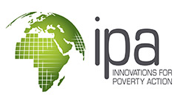
Saving for School with Lockboxes
Organization : Innovations for Poverty Action
Project Overview
Project Summary
School children could deposit savings into a lockbox during a school term and receive their deposits as a payout at the start of the next term.
Impact
There was a significant increase in student test scores (0.11 standard deviations higher than control group).
Cost
The intervention cost $2.24 per student per year.
Challenge
Even when governments eliminate school fees, there are still many costs associated with attending school in developing countries. Providing basic school supplies such as uniforms, pens, pencils, and workbooks is often a significant challenge for low-income families. Furthermore, these families may lack access to formal savings services, making it difficult to set aside money. Even when families have some savings, there is no guarantee they will use the money for educational expenditures.
Commitment devices, which offer an opportunity to restrict future choices, have been shown to be effective in helping people save. However, severe restrictions, while effective for those who want them, can also turn people off and deter participation. Therefore, weaker restrictions may attract more participants—who want their hands tied, but not too tightly—and be a more effective means of changing behavior.
Design
The Super Savers program allowed school children aged 10-15 years to deposit savings into a lock box during a school term and receive their deposits as a payout at the start of the next term. The Private Education Development Network (PEDN) and FINCA Uganda implemented the program in public primary schools in Uganda. Children in grades five through seven, the final three years of primary school, could participate.
During an introductory meeting, the implementation team described the program to the Parent Teacher Association, the School Management Committee, and other interested parents. If they all voted to participate, the implementers provided the school with metal lockboxes. A designated teacher, assisted by student-elected representatives from each class, then managed the program. The implementation team conducted weekly visits to each school to encourage saving and to assist with accounting procedures. Interested students received a passbook in which their individual savings were recorded, and the designated teacher and the implementation team maintained an official register. Depending on a school’s preference, students then deposited money into the lockboxes on a daily or weekly basis.
To provide security and transparency, two padlocks secured each box. Parents elected a representative to keep the key to one lock, while the bank held the other. At the end of each trimester, the two key holders opened the box. The bank representative provided a deposit slip and deposited the funds into the school’s account. The accounts did not earn interest. Inflation varied, but averaged around 10% in this time period, thus the accounts had a negative real interest rate.
After the break between trimesters, the implementation team and bank representatives returned to the school for the payout of the funds. Two representatives signed a withdrawal slip to confirm the withdrawal. The designated teacher, student representatives, and implementers then distributed the money according to the savings register. At the same time, the implementation team organized a small market at each school where students could purchase school supplies or school services such as practice exams or tutoring sessions.
In addition, the implementation team held meetings for parents to inform them about the program. The parental outreach meetings began by identifying the various stakeholders in primary education, their roles and responsibilities. PEDN then discussed the various ways in which parents could support their children’s education. In particular, PEDN explained that in addition to providing a student learning experience, the savings program could be a tool to help families finance their children’s education. A snack and soda were provided to encourage attendance.
Impact
 A randomized evaluation found that some versions of the Super Savers program had a positive impact on savings and educational outcomes. Students saved more when they were offered the less restrictive cash payout which returned their savings in cash compared to the more restrictive voucher payout (see Figure 1). This suggests that the stricter restrictions of the voucher treatment may have deterred students from saving. On average, students in schools that received cash payouts deposited between 2,200 and 2,340 Ugandan shillings, in the parent outreach and no parent outreach groups, respectively, while the average student who received voucher payouts deposited between 1,120 and 1,180 shillings.
A randomized evaluation found that some versions of the Super Savers program had a positive impact on savings and educational outcomes. Students saved more when they were offered the less restrictive cash payout which returned their savings in cash compared to the more restrictive voucher payout (see Figure 1). This suggests that the stricter restrictions of the voucher treatment may have deterred students from saving. On average, students in schools that received cash payouts deposited between 2,200 and 2,340 Ugandan shillings, in the parent outreach and no parent outreach groups, respectively, while the average student who received voucher payouts deposited between 1,120 and 1,180 shillings.
When combined with parent outreach, students who received cash payouts were significantly more likely to have a complete set of school supplies, and owning those supplies led to higher test scores. These students had test scores that were 0.11 standard deviations higher than the control group. There were no significant positive effects on school supplies or test scores among students who received cash payouts without parent outreach or among students who received vouchers, with or without parent outreach. These results suggest that combining cash payouts from savings accounts with parental outreach can lead households to spend savings on education and improve student learning.
Implementation Guidelines
Inspired to implement this design in your own work? Here are some things to think about before you get started:
- Are the behavioral drivers to the problem you are trying to solve similar to the ones described in the challenge section of this project?
- Is it feasible to adapt the design to address your problem?
- Could there be structural barriers at play that might keep the design from having the desired effect?
- Finally, we encourage you to make sure you monitor, test and take steps to iterate on designs often when either adapting them to a new context or scaling up to make sure they’re effective.
Additionally, consider the following insights from the design’s researcher:
What worked best:
- Soft commitments: Giving students a way to lock their money away, while also giving them total freedom in how they could use their savings, generated higher participation rates and better outcomes than tightly restricting how the money could be spent.
- Including parental outreach: The program only led to increased educational expenditures and improved learning when parents were informed and involved.
Cost:
- The program cost US$2.24 per student per year.
- Cost-effectiveness: Using the methodology proposed by Dhaliwal et. al. (2014), the program delivers learning gains at a cost of US$1.49 per tenth of a standard deviation or 6.71 standard deviations per US$100. This is very competitive relative to other programs. Relative to the 27 studies compared by J-PAL, only four produce improvements in test scores more cost-effectively.
- In terms of encouraging family savings, the program costs were high relative to the savings generated. However, if the program generated long-term savings behavior change, then between the continued savings and the improvement in educational outcomes, it would surpass typical cost benefit calculations.
- It may be possible to reduce costs, particularly with implementation via mobile banking. This would obviate the need for the physical transfer of cash to a bank, and would lower the risk of theft from keeping cash in a (albeit locked) box at the school. However, if the group nature of the program was an important element for take-up (through mimicking of peers, or learning from peers) and adherence (through monitoring and potential for social recognition), then a mobile banking implementation may lose that visual classroom element.
Costs you are likely to encounter include:
- Staff time for implementation and monitoring
- Lockboxes
- Transportation costs to the bank
Advice for implementers:
- Make it easy: Selling school supplies at the school the day the cash was paid out likely increased the attention of individuals to educational expenses at exactly the right moment when they had cash in their hands. Therefore, it could be critical to the design of the program.
Project Credits
Researchers:
Dean Karlan Innovations for Poverty Action
Leigh Linden University of Texas at Austin


